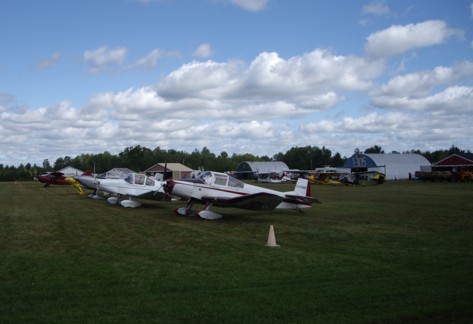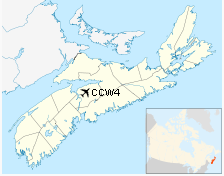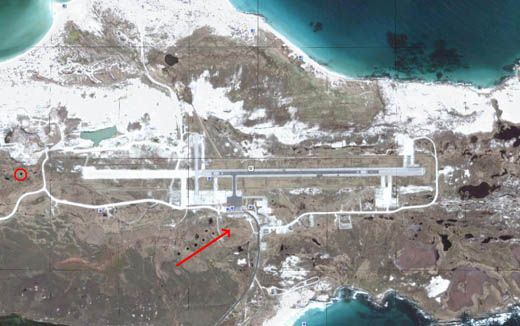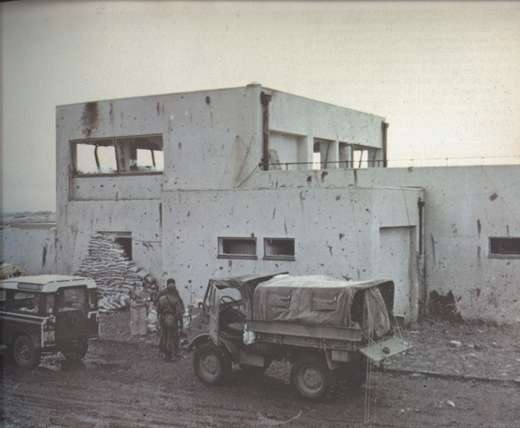 |
|
| Port Stanley Airport |
 |
IATA: PSY – ICAO: SFAL
 |
| Summary |
| Airport type |
Public |
| Operator |
Falkland Islands Government |
| Location |
Stanley, Falkland Islands |
| Elevation AMSL |
75 ft / 23 m |
| Coordinates |
51°41′08.42″S 57°46′39.52″W / 51.6856722°S 57.7776444°W / -51.6856722; -57.7776444Coordinates: 51°41′08.42″S 57°46′39.52″W / 51.6856722°S 57.7776444°W / -51.6856722; -57.7776444 |
| Runways |
| Direction |
Length |
Surface |
| ft |
m |
| 09/27 |
3013 |
918 |
Asphalt |
| 18/36 |
1110 |
338 |
Asphalt |
Port Stanley Airport (IATA: PSY, ICAO: SFAL) is a STOLport in the Falkland Islands, two miles outside the capital, Stanley. The airport is the only civilian airport in the islands with a paved runway. The airport is operated by the Government of the Falkland Islands, and is used for internal flights between the Islands. History
Prior to 1972, there was no airport in the Falkland Islands with a paved runway, and all trips to the islands had to be undertaken by boat. However in the early 1970s, the Falkland Islands Company decided to withdraw its monthly supply ship to Montevideo, Uruguay, increasing the desirability of an air link to the South American mainland.
In 1971, the Argentine Air Force broke the islands' isolation starting with amphibious flights from Comodoro Rivadavia with Grumman HU-16B Albatross aircraft operated by LADE, Argentina's military airline.
In 1973, the United Kingdom signed a Communications Agreement with Argentina to fund an airstrip on the islands. Flights took place again from Comodoro Rivadavia, this time with Fokker F-28 aircraft. This service was maintained until 1982 representing the only connection to the islands. At first, these flights landed at a temporary airstrip at Hookers Point at the east end of Port Stanley where the runway was constructed of Pierced Runway Planking. This situation continued until 1978, when a storm tore up large areas of the runway, rendering it unusable. By this time however a permanent solution was in hand and on 1 May 1979 a new airport was opened at Cape Pembroke by Sir Vivian Fuchs with a 4000 foot paved runway. It immediately became home to FIGAS with its Islanders and Beavers.
The Royal Air Force also used the airport for flights to supply and reinforce the British military garrison when necessary.
Falklands War
 | |
Present-day Port Stanley Airport. Craters from the Falklands War. The white extension is no longer used. |
 | |
Damage caused by Operation Black Buck in the Falklands War |
During the Falklands War of 1982, Argentine forces occupied the airport. The Argentine Air Force were unable to place their most advanced fighter jets at the base given the relatively short runway, and the risk of attack by the British. However, several air force FMA IA 58 Pucarás with Argentine Navy Aermacchi MB-339 and T-34 Mentor for close air support and air reconnaissance were based at the airport. The Pucarás were deployed against the British land forces, shooting down a Westland Scout and the Aermacchis against the British Fleet.
On May 1, 1982, the Royal Air Force started to bomb the airport in Operation Black Buck and several other raids were carried out by embarked Harriers. Through the conflict, the airport installations were attacked with 237 bombs, 1,200 shells by deployed Royal Navy ships and 16 missiles. However, it was never out of action entirely. C-130 Hercules, Lockheed L-188 Electra and Fokker F-28 transport night flights brought supplies, weapons, vehicles, and fuel, and airlifted out the wounded right until the end of the conflict. The Argentines would leave the runway covered with piles of dirt during the day causing British intelligence to surmise that repairs were still in progress. Craters were in fact heaps of earth placed there by the Argentines to make it look as though the runway was damaged. This deception misled the British as to the condition of the airfield and the success of their raids..
After the war, the Royal Air Force took over the airport, renaming it RAF Stanley. Immediately after the conflict air defence of the Islands and garrison was carried out by Sea Harrier FRS.1's and Harrier GR.3's at RAF Stanley and from the aircraft carrier, HMS Invincible, on standing patrol. The runway was extended, paved with Aluminium planking and arrester equipment installed to allow RAF F4 Phantom fighters of No. 23 Squadron RAF to be based on the island as air defence. The Harrier detachment was re-named 1453 Flt. and remained at RAF Stanley to provide standby air defence, in event of excessive crosswinds, until RAF Mount Pleasant was opened in 1985. In addition, long range Hercules transport aircraft of 1312 Flt., resident at RAF Stanley, provided tanker support for the Phantom fighters and transport for local (South Georgia) tasks.
In 1985, RAF Mount Pleasant opened and in April 1986 Port Stanley Airport returned to civilian use. The runway extension was removed bringing the runway down to its present length. Although flights from Chile by a regional airline did use the airport in the early 1990s, for the most part external services have used RAF Mount Pleasant since it opened.
Flights
The Falkland Islands Government Air Service (FIGAS) operates internal flights within the Falkland Islands from the airport. The British Antarctic Survey also uses the airport. Stanley Airport is used by internal flights and provides connections to British bases in Antarctica. A temporary airstrip predating Stanley Airport was opened by the Argentine Air Force on November 15, 1972 (previously, international flights were by seaplane from Comodoro Rivadavia). In 2003 Argentine president Néstor Kirchner ended all flights from Argentina to the Falklands Islands and since then most flights to the Falklands come from Punta Arenas in Chile. LAN Airlines provide these weekly flights to RAF Mount Pleasant from Carlos Ibanez Del Campo International Airport in Punta Arenas.
The above content comes from Wikipedia and is published under free licenses – click here to read more.
| General Info
|
| Country |
Falkland Island
|
| ICAO ID |
SFAL
|
| Time |
UTC-4(-3DT)
|
| Latitude |
-51.685672
51° 41' 08.42" S
|
| Longitude |
-57.777644
057° 46' 39.52" W
|
| Elevation |
75 feet
23 meters
|
| Magnetic Variation |
003° E (01/06)
|
| Operating Agency |
CIVIL GOVERNMENT, (LANDING FEES AND DIPLOMATIC CLEARANCE MAY BE REQUIRED)
|
| Operating Hours |
SEE REMARKS FOR OPERATING HOURS OR COMMUNICATIONS FOR POSSIBLE HOURS
|
| Communications
|
| TWR |
118.1
|
| RDO |
5580
|
| Runways
|
| ID |
Dimensions |
Surface |
PCN |
ILS
|
| 09/27 |
3013 x 63 feet
918 x 19 meters |
ASPHALT |
014FCXT |
NO
|
| 18/36 |
1110 x 42 feet
338 x 13 meters |
ASPHALT |
- |
NO
|
| Navaids
|
| Type |
ID |
Name |
Channel |
Freq |
Distance From Field |
Bearing From Navaid
|
| NDB |
SA |
STANLEY |
- |
305 |
At Field |
-
|
| Supplies/Equipment
|
| Fuel |
Jet A1+, Jet A1 with icing inhibitor.
100/130 MIL Spec, low lead, aviation gasoline (BLUE)
|
| Remarks
|
| FUEL |
(NC-100LL, A1+)
|
| OPR HOURS |
Opr 1200-2200Z++ Mon-Fri
|
| RSTD |
PPR through Director of Civil Aviation.
|
The content above was published at Airports-Worldwide.com in 2010.
We don't guarantee the information is fresh and accurate. The data may be wrong or outdated.
For more up-to-date information please refer to other sources.
|
 |



